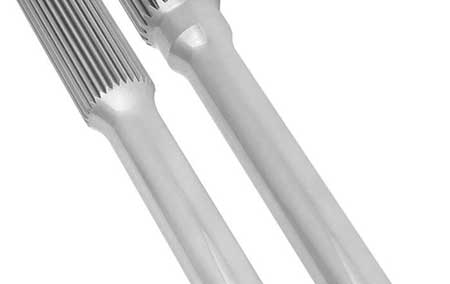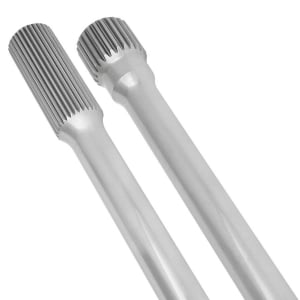If you run a Midwest style modified (UMP, Renegade, IMCA, USMTS and the like) and you don’t have our axles, it’s nearly certain both your axles measure 1.200” in diameter (O.D.). These modifieds range in horsepower anywhere from 375 to 800+. That’s a 425 horsepower difference - yet using the same thickness axles. While the 800+ HP modifieds, in some cases, may require a 1.200” diameter axle (O.D.), there is no reason for running an axle that large in diameter (O.D.) with a modified having less than 750 HP. The 1.200” O.D. axle is nearly the same thickness as a NASCAR Sprint Cup car, running on asphalt with slick tires, 800+ HP, 3400 lbs. and slamming the left side down on pit stops while the wheels are spinning……..at least 4 times during a race. If my 575 HP modified needs a 1.200” diameter (O.D.) axle than I guess I should cover my house with bullet-proof Kevlar in case it rains!
Simply put, axles were made with An O.D. thickness of 1.200” so they could be used on ANY race car and they then simply needed to be made in the different lengths depending on the car/rear-end. 1.200” axle shaft O.D. is the magic number so they fit in ANY axle tube on ANY car, and wouldn’t break: Tremendous “over-kill” for many cars and “good enough” for the higher horsepower cars.
Times have changed…..alloys are sooo much better, heat-treating & manufacturing processes have been refined and racing has simply evolved. Are you running the same shocks you did 10 years ago? Heck, on some tracks a crate motor can out-perform the bigger motors. The mind-set of “bigger is better” doesn’t apply anymore. At Strange we know about racing evolution and keeping pace with it; we’ve been making axles for 50 years, longer than any active racing axle manufacturer in the U.S.
We looked at the modified market as a whole, identified the varying horsepower amongst the different sanctions and classes as well as the tires being used and went to work at understanding in what thickness’ axles (shaft O.D.) could be made. Our objective was to specifically design axles that would encourage twisting (day in and day out) and not risk breaking in any way, under any condition.
We arrived at axle primary shaft O.D.’s specifically for each type of car that will enhance forward-drive through reduced diameters, while also helping put the power down more uniformly as it gets dry-slick. If the axles have more torsional compliance, the tires are less apt to break traction as quick. It’s simple.
While everyone always sides with the aspect of “more forward-drive”, there’s another benefit to consider that’s not usually considered when you think of axles. If we said that you could pull as much as an inch of tire stagger out of the car and the car will still respond the same as though you never removed it, perhaps we’d have your attention?
We refer to this as “axle stagger”. The handling characteristics of the car are very much the same as with tire stagger but to a smaller degree. We achieve this by making the left hand axle thinner in shaft outer diameter than the right axle. The bigger the diameter (O.D.) differential between the left and right rear axles the “looser” we can make the car.
That said; let me make a few points before clarifying the “axle stagger” more definitively.
With nearly every Modified we’ve come across they’re either using:
Mods using a 9” rear end
- Left Rear = 28.50” axle
- Right Rear = 32.50” axle
OR
Mods using a Quick-Change rear end
- Left Rear = 30.50” axle
- Right Rear = 30.50” axle
While some may differ from this slightly, for the sake of this write-up - you have either a 4” difference between your left & right axle (w/9” rear end)…..OR….your axles are very close to being equal lengths left-to-right (quick-change rear end).
With axles that differ in length (i.e. w/the 9” rear end), if we made the left and right axle shafts with the same O.D. they wouldn’t respond (twist) the same under torque. The shorter axle would twist less because it’s shorter than the right by 4”. This would give the car a “throttle push” of sorts on corner-exit when on-throttle initially. The greater the difference in left-to-right axle lengths, the more ‘throttle push” you’ll experience.
Same thing goes on restarts…..the left rear tire breaks traction before the right rear tire because the left axle is shorter, so you are pulling the wheel down from right to left for an instant. By making the right rear the thicker axle we can eliminate this altogether by equalizing the torque through the axles with the different axle (O.D.) diameters. By making the left-to-right axle outer-diameters split greater, we can actually reverse this characteristic or “loosen” the car up
> Enter “Axle Stagger” as mentioned earlier.
For those with a quick-change rear end, your axles are nearly the same length (or are the same). With equal length axles the “twist rate” of the axles is equal under torque so only a minor left-to-right axle outer-diameter change is needed to have an effect. Again, the more outer-diameter differential you have between your left and right axles, the looser you can make the car under acceleration……”axle stagger”.
We’ll often tell people to run a solid axle on the right and a gun drilled axle on the left and you can see what the different axle spring rate does; however, this really only works with cars with higher horsepower. We firmly believe that those who run B-Mods and Sport Mods have “so much axle” that both rear tires immediately break traction, this kills your forward bite. The 1.200” standard O.D. axles used in a modified with less than 800 HP simply have no give, they’re “overkill”. A typical 575 HP Strange Oval axle outer-diameter combination for a IMCA
A-Mod modified would be a left rear with an O.D. of 1.080” and a right rear with a 1.130” O.D.
Significantly smaller O.D. than the 1.200” O.D. axles you may be using now…..and lighter as well.
Now, just say you’ve got our axles in the car…..the other thing to consider is the rear inboard axle seal (rear-end side). Remember, you’re dropping the axle (O.D.) diameters down so you’ll need our purpose-built 2 stage inboard axle seals for the smaller O.D. axles or you’ll have rear end fluid sloshing around your axle tubes. We asked SEALS-IT to make us our own axle seal in order to accommodate the smaller O.D. axles. SEALS-IT has been supplying NASCAR teams with various seals for over 20 years and it’s all they do……it was a “no brainer” for us to partner with them.
These inboard axle seals will fit either a 2.50” or 2.75” I.D. axle tube, and are made of high temperature rubber incased in a lightweight alloy housing. When you run axles that can sometimes be as small in diameter as 0.940” you most certainly will be losing rear end fluid the first time out. Eliminate the headache straight away and get our SEALS-IT inboard axle seals, you’ll be happy you did.

